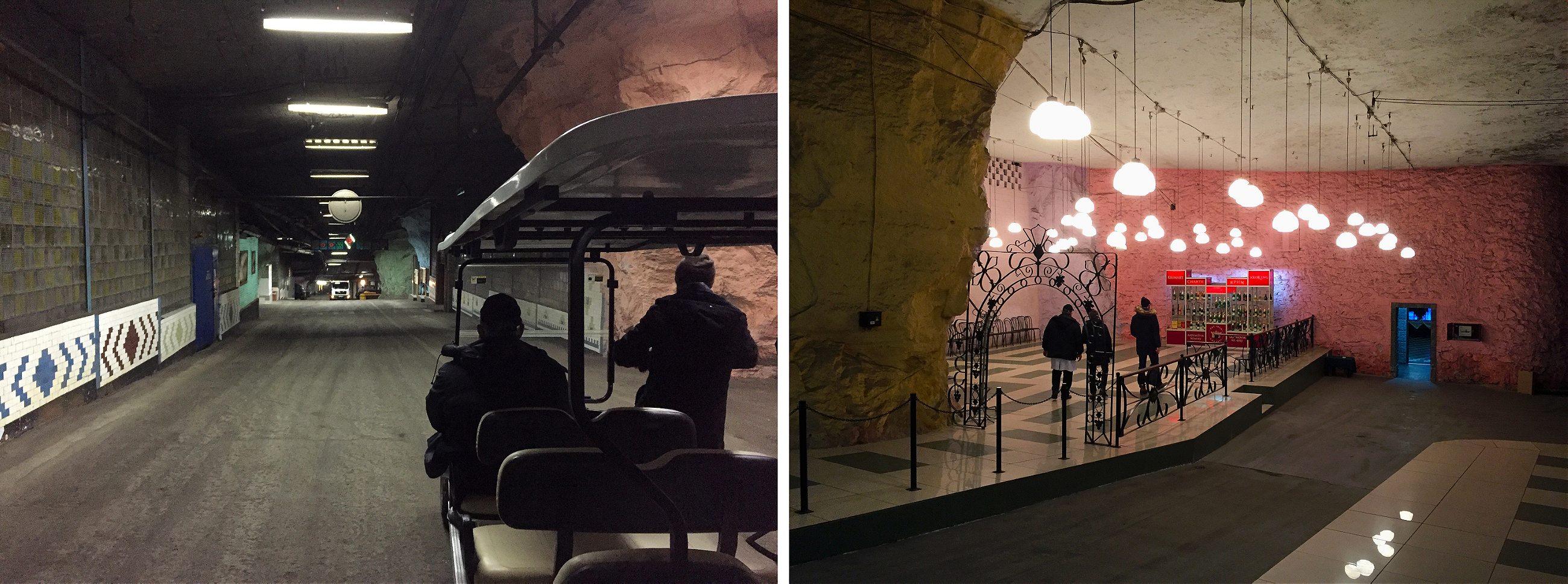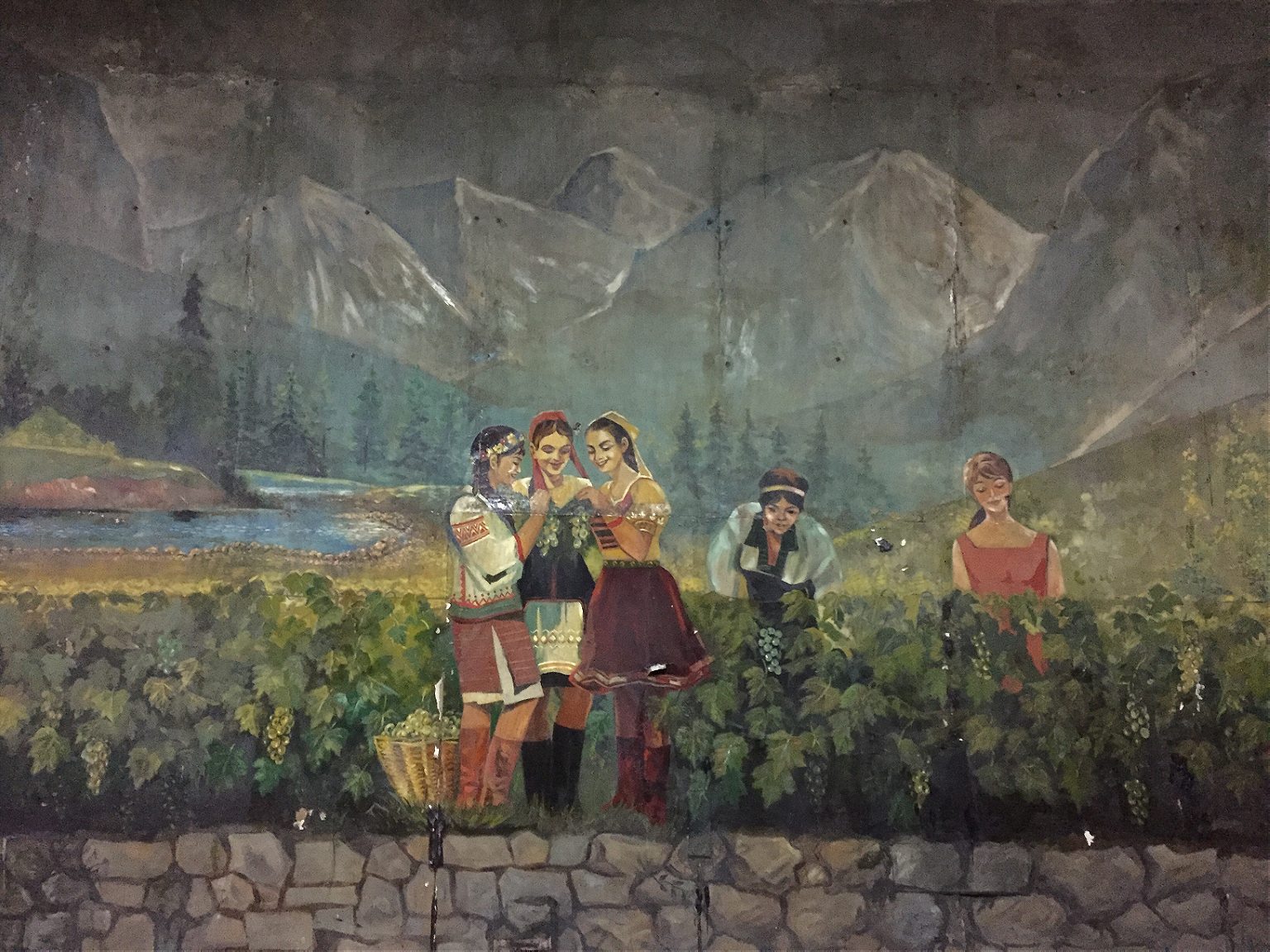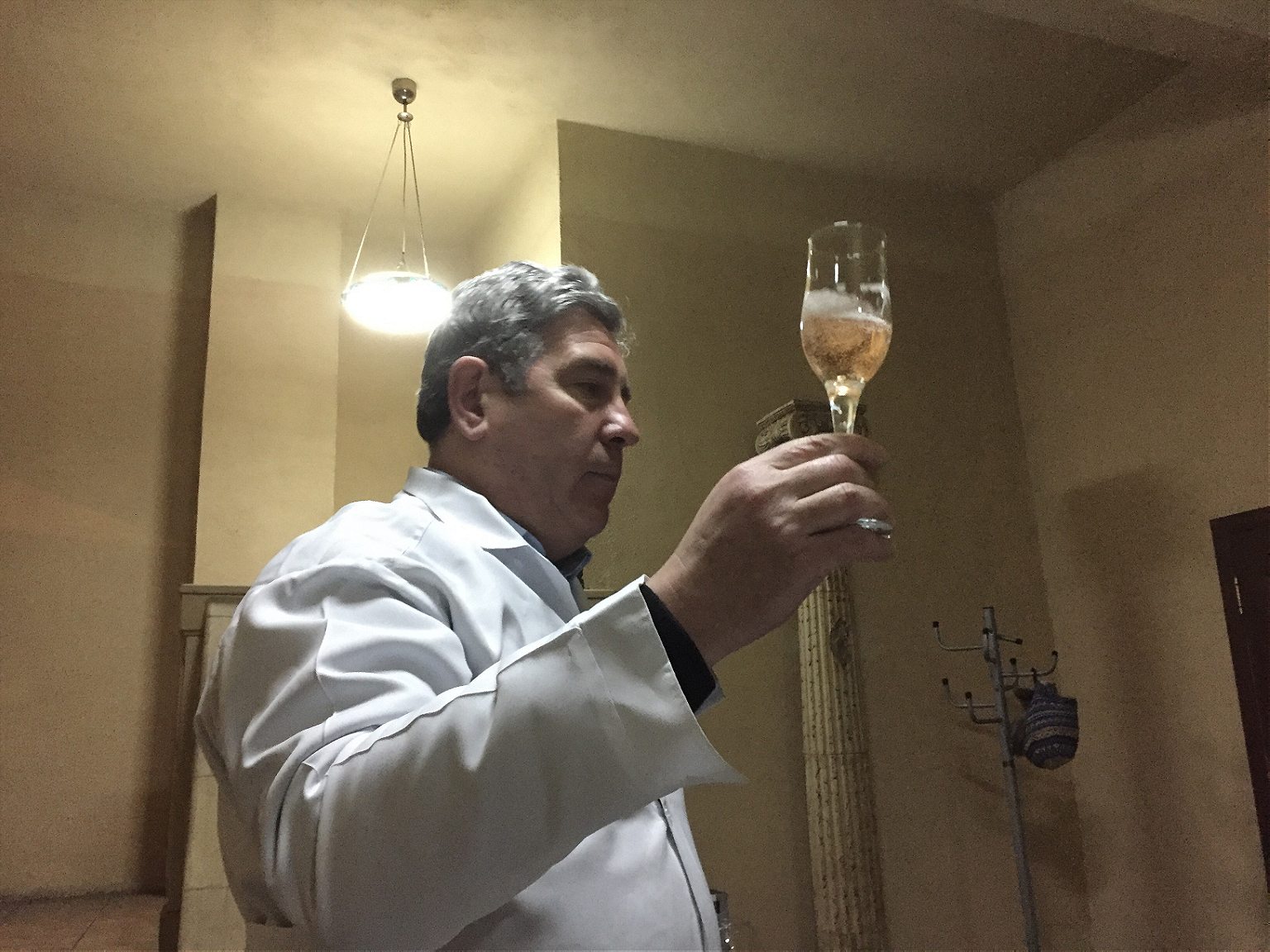On Ukraine’s eastern front, a winery is cranking out the sparkling wine of Stalin’s dreams.
Geometric brick courtyards radiate outwards from a cluster of buildings. A closer look, however, reveals a large, dark entrance to a tunnel between two of the structures. Above it is a relief of a nude couple surrounded by grapevines.
This is the Artwinery, the largest producer of sparkling wine in eastern Europe. It occupies nearly three million square feet of tunnels in a former mine that descends up to 250 feet below the earth. Opened as a birthdays gift to Joseph Stalin in 1950, it is where he tried to bring class war to the liquor cabinet by creating “champagne for the people.”
Today it sits a stone’s throw from where Ukraine is fighting a war with Russian proxies. From Soviet industrial powerhouse to post-Soviet decline to a nostalgia-driven revival and now hostage to an ongoing geopolitical struggle, the winery has long seen its fortunes rise and fall with Ukraine’s as the country’s relationship with its eastern neighbor has changed.
We enter the tunnel. Once we emerge from the darkness, we are surrounded by echoing caverns with brightly painted walls, like something out of Willy Wonka and the Chocolate Factory. My guide through this Soviet anachronism is Yuriy, a middle-aged local man who has worked at the winery—in Russian, a “factory”—for decades. He has an encyclopedic knowledge of the place, which he rattles off with a Soviet kind of seriousness and emphasis on production and statistics. He is the master of the winery’s secrets, and today he is driving me around in a tourist golf cart—the kind you usually see in Disney World—that there is seldom a use for in eastern Ukraine anymore.

In Yuriy’s story, Stalin plays the defining role in the creation of the winery, a narrative that has likely changed little since the autocrat was alive. Creating the winery in a massive former alabaster mine is just another of his mythic, Herculean labors. Here, Stalin created a five-year plan for champagne just as he created one for coal and steel production that also transformed eastern Ukraine.
As a Georgian, Stalin came from a part of the Russian Empire with a real wine culture, where wine is carefully cultivated and sipped rather than used as substitute for vodka. Here, Stalin took that tradition and recreated it on monstrous scale.
Yuriy rattles off more statistics. Within its first four years of opening, the factory produced 1.3 million bottles of what they labelled champagne, ignoring the French requirement that the term “champagne” only be applied to sparking wine from the Champagne region of France. In 1959, that number doubled to 2.7 million bottles and continued to grow. Stalin’s aim was to provide Soviet citizens—after years of wartime rationing—with a desirable consumer good that everyone could afford. That could only be achieved with production on a massive scale.
This abandoned alabaster mine was chosen because its huge size allowed it to accommodate wine making of the scale Stalin envisioned. But there were also clear drawbacks, as the steppe winters were far too cold for grapevines. As a result, grapes had to be brought in from the south: from Georgia, Crimea, Odessa, and Moldova. That tradition carries on today in many of the winery’s reds, which still use Georgian saperavi grapes.
Yuriy tells me more stories as we drive deeper and deeper into the caverns. Every so often, we stop so I can take pictures of one of the surreal Soviet murals on the walls. There are smiling young women in folk costumes collecting grapes, birds getting drunk on red wine and starting fights, and bears smoking while enjoying a bottle of Soviet brut.

The unimaginatively named Soviet Champagne was the winery’s first wine and flagship brand. With its iconic black and silver logo, it was instantly recognizable and the champagne in the Soviet Union. That’s not to say it’s particularly good. Soviet Champagne is saccarine, too sweet for most Westerners; it is said it mirrors Stalin’s own tastes. But for people who grew up behind the Iron Curtain, it is the taste of youth, inextricably intertwined with memories of school graduations, holiday celebrations, and the best kind of long nights. Artwinery has worked hard to hold onto this nostalgia market. After the collapse of the Soviet Union, they changed the name of the wine to Artemovsk, after the Soviet name of the city where the winery is located, to keep the Soviet association.
But in 2015, de-communization laws, found in weaker forms in many post-communist states but absent in Ukraine until after the most recent hostilities began, forced the winery to re-brand once again, as the town—named after a Russian Bolshevik in 1924—re-adopted its pre-revolutionary name, Bakhmut. The winery has compromised, changing its name from the Artemovsk Factory of Champagne Wines to Artwinery, but they are fighting to keep the valuable Artemovsk brand for the wine itself.
There are ways of getting around such rules, of course, and some find it worthwhile for the uniquely associations of grandeur. At a recent “communist functionary” themed party I attended, twenty-something Ukrainians and ex-pats mixed on the top floor of one of Kiev’s elite Stalinist high rises in an apartment that has passed from the old Soviet elite to the new capitalist one. That night, as people looked down on the bright lights of Kiev’s main drag, there was no shortage of Soviet Champagne. Closer inspection, however, revealed that instead of the Russian “Sovetsky” or “Soviet,” they instead bore the nonsensical name “Sovetovskoe,” which, owing to its complete lack of meaning, skirts the new regulations.
I follow Yuriy past a giant bust of the the Roman god of wine, Bacchus, carved into the alabaster wall. Yuriy brings me a to a map of Artwinery’s exports. In 2003, they produced over 12 million bottles of champagne, 58 percent of which was exported. Before the war, Russia was the largest foreign market, but now Russian-imposed trade restrictions have cut them off entirely. Now Germany, home to the largest Russian-speaking community in Europe outside the former Soviet Union, is the largest market. There, a bottle of one of Artwinery’s wines goes for about 10 euro, far more than the $3 is usually costs in Ukraine.
Artemovsk, however, was not the only major brand. After Russian annexed Crimea in February 2014, many Ukrainians were surprised to still be able to find Crimea Champagne on store shelves, even as Crimean restaurants suddenly found themselves cut off from their supplies of Crimean wines. Not so for the Crimea Champagne, the grapes of which came from Crimea, but which was made deep within these caverns.
The loss of a vital market is not the only way in which the war has affected the winery. In 2014, separatists briefly took control of the town of Artemovsk. There was a shoot out with one of the security guards at the winery, but the rebels didn’t enter the caverns. But it is the economic impact that has been most lasting. With most bottles taking three years to produce, the winery has drastically cut back production and is instead hoping to sell some of the millions of bottles still sitting, unsold, in the caverns.
Passing rows of bottles, Yuriy takes me to see how the bubbles are formed in the champagne. Row after row of wooden stands contain bottles full of wine that must have their elevation increased at pre-determined intervals to ensure proper development. It is the sort of time consuming work requiring huge supplies of laborers that was only possible in the Soviet Union. Since 2003, much of the work has been automatized with the staff of the winery reduced to some 500, who now screen bottles for impurities on conveyor belts and use French-made tilting machines rather than doing the work by hand.
Amidst the kitschy murals and whirling modern technology, however, the caverns also have a darker side. In 1942, Nazis took control of the area. After a building caught fire in Artemovsk, they blamed the city’s Jewish community. Nazi forces rounded up the local Jews and kept them in a basement for two days without food or water. Then they took them to these same mines and sealed all 3,000 of them in tunnel behind a fresh new brick wall. In their report, Sonderkommando 4b stated “with this action, the district of Artemovsk was also freed of Jews.”
When the Soviet army retook the city and opened the tunnel, they found only a few of the victims had gunshot wounds, presumably to force them into the tunnel. The rest were left to die. When the Soviet officers discovered the bodies, they were well preserved due to the same factors that later led Stalin to choose this site for his winery: dry air and even, low temperatures. The bodies were then brought out for relatives to identify.
We come up to the site of the tunnel in our golf cart. It is another regular stop on the wine tour. The Soviet monument denies these victims their religious identity, referring to them only as “Soviet citizens who lost their lives.” In the Soviet worldview, identity was determined by class, leaving no room for religious or ethnic minority identities. A newer plaque from the local Jewish community calls for God “to remember the souls of Artemovsk’s Jews,” and there are memorial sculptures and candles built into the wall.
After the memorial, Yuriy brings me to a tile area set against a pink cavern wall with 70s-style display cases, each holding one of their signature bottles of wine. Yuriy again talks about their famous brands, and it dawns on me that his spiel was designed to impress high ranking-party functionaries rather than tourists.

Yuriy then takes me into a cavern with a long circular table and heavy, throne-like wooden chairs. This was where the real high-level functionaries came to party. Luminaries from First Secretary of the Communist Party of Ukraine Petro Shelest to Ukraine’s second president Leonid Kuchma all made visits. Noticeably absent, however, has been current Ukrainian President Petro Poroshenko. With the winery partially owned by political opponents like oligarch Rinat Akhmetov, he is not expected to make a visit any time soon.
From the throne room, Yuriy takes me past a formal dinning area bedecked with statues of Poseidon and Athena to a private tasting room. Here, he puts on his white lab coat and begins to instruct me in the carefully scientific process of wine tasting. Each glass must be lifted to the light, carefully tasted, and described. Yuriy briefly remarks with sadness how after the Soviet Union collapsed, the French made them drop the word “champagne” from their bottles, but soon moves on.
I try a mixture of their sparkling wines: white, rosé, and red. Most are too sweet for me, but there is one clear standout: the Krimart brut. It has a rich, dark-red color and smells of raspberries. Rather than the sweetness overpowering the red wine, the red wine gives substance to the effervescence.
From there, it is back into the golf cart and into the dark evening. The workers are leaving the premises of the winery as they would any other factory job. I walk with them, stepping out from Stalin’s subterranean technicolor winery, and back into the real world.